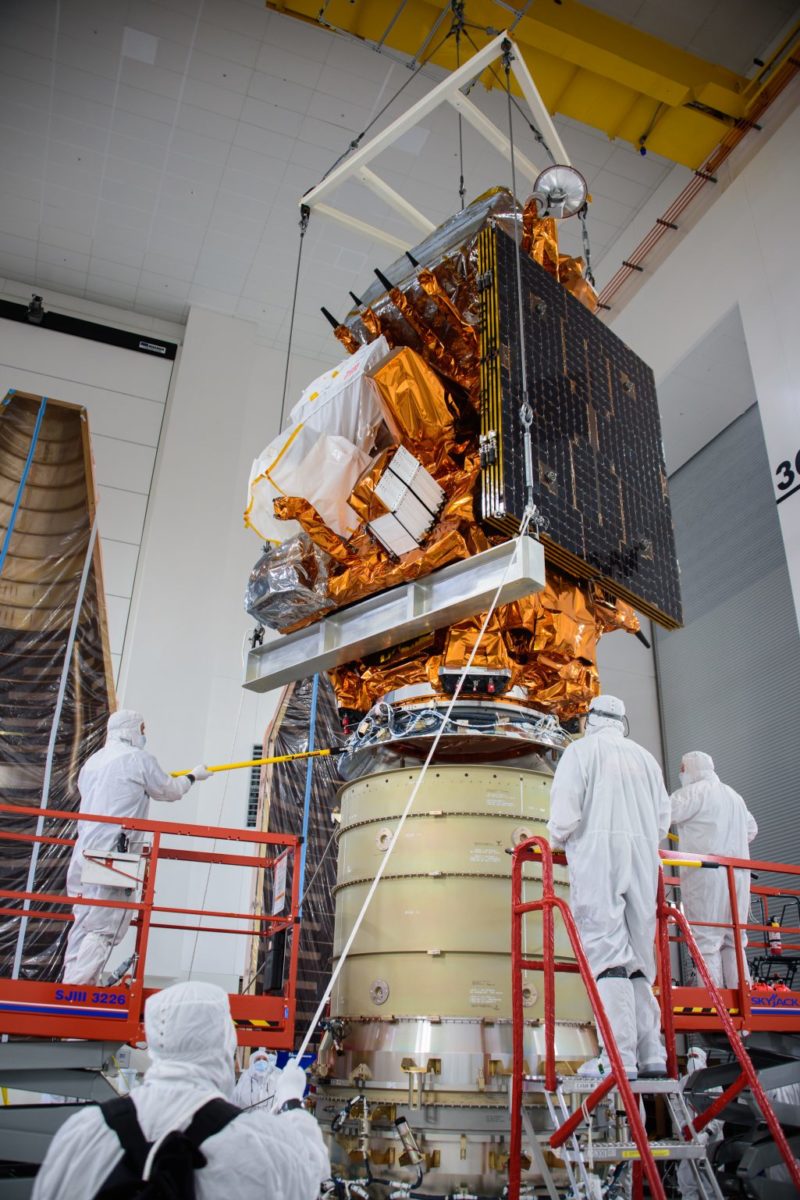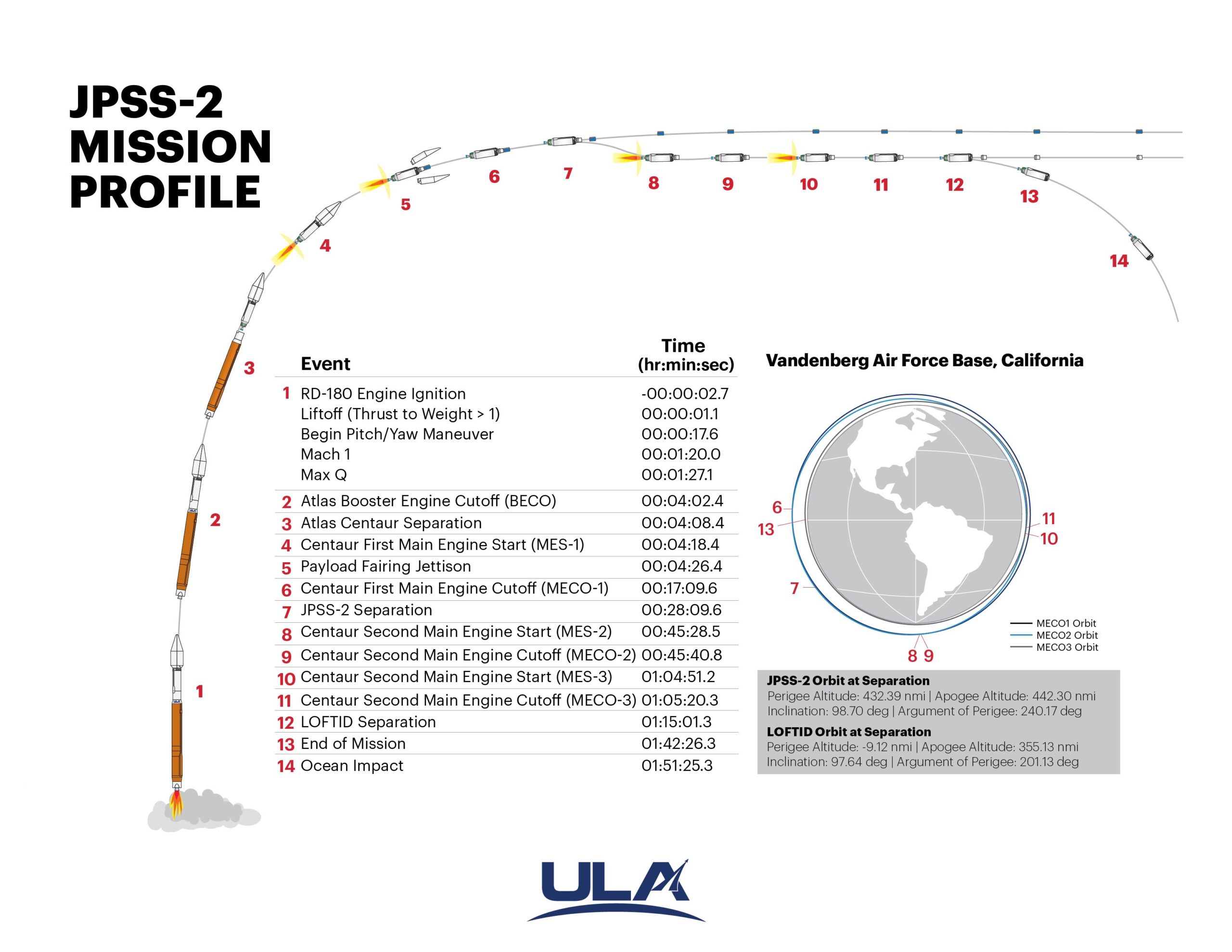
In its eighth mission of 2022, United Launch Alliance (ULA) has successfully launched the second Joint Polar Satellite System (JPSS-2) for the National Oceanic and Atmospheric Administration (NOAA)—second in a four-strong fleet of weather-watching spacecraft, the first of which rose to orbit back in November 2017—alongside a cutting-edge inflatable re-entry demonstrator for NASA. Liftoff of ULA’s venerable Atlas V occurred from Space Launch Complex (SLC)-3E at Vandenberg Space Force Base, Calif., at 1:49 a.m. PST (4:49 a.m. EST) Thursday, 10 November.

Flying pole-to-pole at an altitude of 512 miles (824 kilometers)—and crossing the equator 14 times daily—JPSS-2 supports the United States’ next-generation environmental monitoring network. It seeks to increase the timeliness and accuracy of climatic and weather-related forecasting and minimize risks to human life and property.
When it enters service, JPSS-2 will be numerically redesignated “NOAA-21”, joining a long line of environmental monitoring satellites, with a heritage that extends back to 1970. It is expected to remain operational well into the next decade.

The 6,460-pound (2,930-kilogram) spacecraft, equipped with four highly advanced weather-watching instruments, was built by Northrop Grumman, on the foundation of its tried-and-true LEOStar-3 “bus”. The third and fourth members of the fleet—also fabricated by Northrop Grumman—are slated to launch in 2028 and 2032, respectively, with the Ball Aerospace-built JPSS-1 having been placed into orbit five years ago.
Aboard JPSS-2, the 22-channel Advanced Technology Microwave Sounder (ATMS) will furnish sounding observations to retrieve atmospheric moisture and temperature profiles for real-time civilian weather forecasting and climate monitoring. In development by Northrop Grumman since 2016, the instrument was fully assembled and entered its environmental testing phase in October 2019.

The Cross-track Infrared Sounder (CrIS), built by L3Harris Technologies, produces high-resolution, three-dimensional “maps” of moistures, pressures and temperatures to enhance weather forecasting models and improve understanding of more “regular” climatic phenomena, including El Niño and La Niña. CrIS was declared structurally complete and passed its pre-ship review in May 2020.
JPSS-2’s final pair of instruments are the Ozone Mapping and Profiler Suite (OMPS), manufactured by Ball Aerospace, which consists of a trio of hyperspectral instruments to extend a quarter-century-plus of continuous ozone measurements. And the Visible Infrared Imaging Radiometer Suite (VIIRS), built by Raytheon, will collect global visible and infrared data of land, oceanic and atmospheric parameters at very high temporal resolutions.

A fifth sensor for JPSS-2—the Radiation Budget Instrument (RBI)—was formally deleted by NASA in January 2018. Intended to map the Home Planet’s emitted radiation with a highly sensitive scanning radiometer, RBI suffered significant cost overruns and technical difficulties which led it to be defunded under the Trump Administration and precipitated its eventual cancelation.
In the late summer and early fall of 2020, JPSS-2’s instruments—firstly VIIRS, then OMPS, followed by ATMS and lastly CrIS—commenced shipment to Northrop Grumman’s facility in Gilbert, Ariz., for integration aboard the spacecraft. Following integration, a three-month Thermal Vacuum (TVAC) testing phase was concluded last June.

JPSS-2’s 30-foot-long (10-meter) five-panel solar array underwent deployment trials in late July and early August. A minor test anomaly with VIIRS and resultant equipment repairs delayed the completion of TVAC by a month, which pushed the launch date back from 30 September to no earlier than 1 November.
Finally, on 19 August JPSS-2 arrived via truck from Northrop Grumman’s facility in Gilbert, Ariz., at the Astrotech Space Operations Facility at Vandenberg. By this time, the hardware for the mission’s launch vehicle had also begun to arrive on the West Coast.

In March 2017, NASA tapped ULA for the $170.6 million launch services contract to deliver JPSS-2 via an Atlas V to its intended orbit. At the time of the contract award, the mission was targeted to fly out of Vandenberg in November 2021, but a combination of factors, including instrument and JPSS-2 testing and the ravages of the COVID-19 coronavirus pandemic, pushed that target back by a full year.
Flying in its “401” configuration—with a 14-foot-diameter (4-meter) payload fairing, no strap-on solid-fueled boosters and a single-engine Centaur—the hardware for the Atlas V arrived at Vandenberg from ULA’s factory in Decatur, Ala., over the summer. A few days after the arrival of JPSS-2, the mission’s second payload also arrived.

The Bernard Kutter Low-Earth Orbit Flight Test of an Inflatable Decelerator (LOFTID) was sponsored through the Technology Demonstration Missions program of NASA’s Space Technology Mission Directorate (STMD). It seeks to evaluate new techniques and methodologies to re-enter and land payloads, including through thinner atmospheres, like that of Mars.
NOAA announced back in July 2018 that it was offering “a satellite rideshare” on the JPSS-2 mission. A year later LOFTID formally came aboard.

Current heat-shield technology is physically rigid, and rigidly constrained by the parameters of a launch vehicle’s heat shield. Added to that, much larger payloads—equivalent in size and mass to a small house—will be needed to get the first human explorers safely onto the dusty surface of the Red Planet.
The issue is complicated yet further by the fact that Mars’ atmosphere is thick enough to provide a measure of aerodynamic drag, but not enough to facilitate effective and rapid deceleration of an incoming payload. LOFTID will deploy an inflatable aeroshell, some 19.7 feet (6 meters) in diameter and 5.9 feet (1.79 meters) tall when fully unfurled.
LOFTID is dedicated to the memory of Bernard Kutter, ULA’s manager of advanced programs, who died in August 2020. Mr. Kutter was a tireless advocate for low-cost access to space and a champion of inflatable heat-shield technologies. A small portion of his ashes are flying aboard LOFTID.
Last month, tightly wrapped inside its drum-like canister, LOFTID was mated to the JPSS-2 spacecraft, bringing the total height of the combined payload “stack” to 27 feet (9 meters). A few days later, the stack was encapsulated within its 4-meter-wide (14-meter) Extended Payload Fairing (EPF).

Elsewhere, the Atlas V’s Launch Vehicle On Stand (LVOS) milestone took place on 28 September, when the 107-foot-long (33-meter) Common Core Booster (CCB) was hoisted vertical inside the Mobile Service Tower (MST) at Vandenberg’s historic SLC-3E. Over the following days, the interstage, Centaur and “boattail”—the lower portion of the payload fairing—were also added.
The EPF and its encapsulated payloads were transferred to the pad and lifted into position atop the stack on 18 October, topping off the Mighty Atlas at a height of 191 feet (58.2 meters). The Launch Readiness Review (LRR) initially targeted an opening launch attempt on 1 November, but on 29 October teams elected to delay the mission until no sooner than 9 November (and ultimately settled on the 10th) in response to the need to replace a faulty battery aboard the Centaur.

A second LRR last Tuesday produced a definitive “Go for Launch”, targeting a 36-minute “window” that opened at 1:25 a.m. PST (4:25 a.m. EST). Weather conditions at Vandenberg were predicted to be 90-percent-favorable, with scattered low stratus clouds and visibility for 1-3 miles (1.6-5 kilometers).
After holding briefly at T-4 minutes to rectify a Liquid Oxygen (LOX) sensor issue, the Mighty Atlas powered uphill at 1:49 a.m. PST (4:49 a.m. EST), its Russian-heritage RD-180 engine providing more than 860,000 pounds (390,000 kilograms) of thrust for the initial four minutes of the flight.

Following the separation of the CCB, the Centaur ignited for the first of three highly complex “burns” to deliver JPSS-2 into orbit and pre-position LOFTID for re-entry.
The first Centaur burn lasted almost 13 minutes and was expected to culminate in the safe deployment of JPSS-2 at 28 minutes after launch. Two more burns, lasting just under a minute apiece, served to lower the upper stage’s altitude to establish LOFTID on its proper trajectory to intercept Earth’s atmosphere.
After achieving the proper conditions, the Centaur was set to reorient itself, the launch canister was to be ejected and the upper stage will “wake” LOFTID to begin its inflation process using gaseous nitrogen. Centaur will execute a spin-up maneuver to stabilize the payload, before releasing it at 75 minutes after launch.
During re-entry, LOFTID’s flexible thermal protection system is expected to withstand peak temperatures in excess of 2,200 degrees Celsius (4,000 degrees Fahrenheit). The demonstrator is targeting a parachute-aided splashdown in the Pacific Ocean, east of Hawaii, for subsequent recovery and data analysis.

Thursday’s flight was the 301st and final launch of an Atlas-class vehicle from Vandenberg, ending a historic journey which began way back to September 1959. It also represented the 17th flight of an Atlas V from the West Coast since March 2008.
It is expected that the rocket’s 20 remaining flights—including a Crewed Flight Test (CFT) and six Post-Certification Missions (PCMs) of the Boeing CST-100 Starliner to the International Space Station (ISS)—will originate from storied Space Launch Complex (SLC)-40 at Cape Canaveral Space Force Station, Fla.
With today’s launch, ULA wraps up a banner 2022 of eight missions, including seven by the Atlas V and the final flight by the Delta IV Heavy out of Vandenberg in September.
These included Boeing’s CFT, three dedicated missions for the U.S. Space Force, a classified payload on behalf of the National Reconnaissance Office, two for NOAA—JPSS-2 and the latest Geostationary Operational Environmental Satellite (GOES-T)—and a dual-stacked pair of commercial communications satellites for Luxembourg-headquartered SES.





